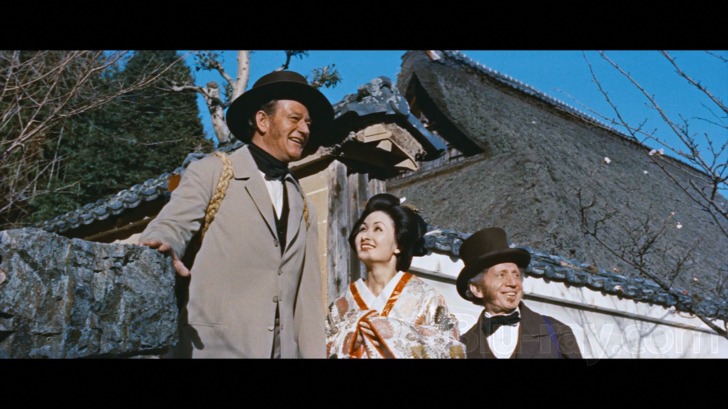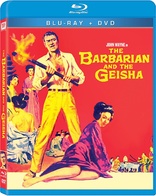The Barbarian and the Geisha Blu-ray Movie
HomeThe Barbarian and the Geisha Blu-ray Movie 
Blu-ray + DVD20th Century Fox | 1958 | 105 min | Not rated | Nov 13, 2012
Movie rating
6.3 | / 10 |
Blu-ray rating
| Users | 3.5 | |
| Reviewer | 3.0 | |
| Overall | 3.4 |
Overview
The Barbarian and the Geisha (1958)
In 1856, the first U.S. Consul General to Japan discovers hostility to foreigners, as well as the love of a young geisha.
Starring: John Wayne, Eiko Ando, Sam Jaffe, Sô YamamuraDirector: John Huston
| History | 100% |
| Drama | 91% |
| Adventure | Insignificant |
Specifications
Video
Video codec: MPEG-4 AVC
Video resolution: 1080p
Aspect ratio: 2.36:1
Original aspect ratio: 2.35:1
Audio
English: DTS-HD Master Audio 4.0 (48kHz, 24-bit)
French: Dolby Digital Mono
Spanish: Dolby Digital Mono
Subtitles
English SDH, Spanish
Discs
50GB Blu-ray Disc
Two-disc set (1 BD, 1 DVD)
DVD copy
Playback
Region free
Review
Rating summary
| Movie | 3.0 | |
| Video | 4.0 | |
| Audio | 4.0 | |
| Extras | 2.0 | |
| Overall | 3.0 |
The Barbarian and the Geisha Blu-ray Movie Review
John Wayne, John Huston, and the film you’d least expect them to make together.
Reviewed by Casey Broadwater May 31, 2012When you think of John Wayne, you probably think of white hat versus black hat westerns. A gunslinger with a moral code. A sheriff of decisive, spur of
the moment action. A man with a plan and nothing to stop him from seeing it through. Diplomatic, then, isn't the first word—or even the
fiftieth—you'd normally use to describe him, so it's a bit of a shock to see Wayne as an American envoy to Japan in John Huston's 1958 historical
melodrama The Barbarian and the Geisha. You keep waiting for him to pull out a six-shooter or bust some skulls, but for the most part, his role
here is simply to be patient, to bide his time. He spends much of the film idly waiting for the Japanese powers that be to make up their minds about his
presence. And obviously, waiting is not what most audiences wanted or want from a John Wayne movie.
Unsurprisingly, Barbarian tanked at the box office and debuted to mostly dismissive reviews from the likes of The New York Times'
Bosley Crowther, who wrote that Mr. Wayne "appears a little bewildered and repressed, being much more accustomed to action." What Crowther
missed is that Wayne's restrained and uncomfortable "other-ness" as a gaijin in Japan is essential to story. With his cowboy swagger and deep
commanding drawl, Wayne typifies every Japanese stereotype about brash, take-charge Americans, and Barbarian's specific frisson comes from
seeing his character stumped and stymied by a culture that values group-think over individualism.

The film is set in 1856, two years after Commodore Perry sailed his "black ships" to Japan and negotiated the Kanagawa Treaty, beginning the process of ending two centuries of Japanese isolationism. The treaty also attempted to established the right for the U.S. to open a consulate in Shizuoka, but a lost-in-translation miscommunication left the Japanese with the assumption that a consul would only be invited at the shogunate's discretion.
Prefectural Governor Tamura (Tokyo Story's So Yamamura) is none too pleased, then, when newly appointed Consul-General Townsend Harris —John Wayne in an uncharacteristic top hat and mutton chops—arrives on the shore of Shimoda town with his faithful translator Henry Heusken (Sam Jaffe) and three Chinese servants. And it certainly doesn't help diplomatic first-impressions when Harris' ship fires off a cannon salute, which scares the peasants, who mistake it for an act of aggression. Already, we're seeing a clash of cultures, with Harris as the won't-take-no-for-an-answer American imperialist and Tamura bound to tradition and the hierarchy of feudal power.
After much deliberation, it's decided that Harris—in a strictly unofficial, temporary capacity—will be allowed to stay on the outskirts of town in an abandoned house next to the cemetery. And so the waiting begins. Though short on plot, the beats of the film's story convincingly emphasize the unavoidable friction between East and West. Harris occasionally asserts himself, raising a minor fuss when he finds out Tamura has ordered the locals not to sell him goods, but he learns to be tactful too, even agreeing to take down the American flag outside his ramshackle "consulate" and only fly it during holidays. The only real action in the film, per se, is limited to a cholera outbreak—which Harris tries to squelch by burning down the city, another misunderstood act—and a brawl with a giant ronin and a pint-sized judo master. Harris gets his ass unceremoniously handed to him, a sight we don't often see in John Wayne movies.
A romantic subplot supplies the film with most of its (melo)dramatic substance. With orders from the shogun to stall and keep Harris entertained, Tamura sends the would-be consul a seventeen-year-old geisha named Okishi (Eiko Ando), and a chaste, slowly blossoming relationship inevitably follows. Their love is tested when Okishi—duty bound to Tamura—is ordered to assist in a dark scheme to assassinate Harris before he can convince the shogun to sign a new treaty.
A former burlesque dancer and singer, Ando had no prior acting experience—and would never appear in another film—but she's graceful and beautiful on screen, which is really all the role requires of her. And while John Wayne does seem slightly stodgy and uneasy as a romantic lead with little to do, it's interesting to see him playing an atypical part like this. As counterintuitive as it might seem, the casting does make sense. If Huston was looking for a lead who'd be perfect as the big, unrefined American awkwardly bumbling through delicate Japanese tatami rooms, he couldn't have done much better than Wayne.
Unfortunately, Wayne and John Huston didn't get along—they supposedly got into a fistfight on set—and Wayne demanded there be significant changes made to the story. After shooting was finished, 20th Century Fox drastically recut the film, and watching it now you can definitely sense that there's something off with the editing and pacing. Certain scenes will abruptly end, dissolving into the next without a feeling of closure. It's frustrating to imagine what the film might've been like if Huston—who ultimately wanted to remove his name from the credits—had a say in the final cut. Films like Rashomon, Seven Samurai, and Jigokumon had introduced Japanese cinema to the West in the mid 1950s, and Huston allegedly wanted Barbarian to have a similar style and feel. It doesn't, sadly, on the whole—the vibe is distinctly Golden Age Hollywood—but there are traces of authenticity. The film was shot almost entirely in Japan, utilizing beautiful outdoor locations in Kyoto and Nara, along with indoor sets at Toho Studios, and it does capture some of the pageantry and color of Japanese festivals during the late Edo period. While it's flawed and far from Wayne or Huston's best, The Barbarian and the Geisha is a career curiosity for both and well worth a look.
The Barbarian and the Geisha Blu-ray Movie, Video Quality 

Whatever your thoughts on the story, there's no denying that The Barbarian and the Geisha is a beautiful film, with lushly colored Cinemascope photography that strikingly captures the on-location-in-Japan scenery and Toho Studios interior set design. A quick comparison between the Blu-ray and the included DVD shows a clear difference between the high and standard definition versions, most notably in terms of clarity. The 1080p/AVC-encoded image might not be exceptionally sharp by today's standards, but detail is strong in the areas where you normally look for it—facial features, clothing, in-focus props—and overt blurriness only occasionally affects the far edges of the 2.35:1 frame. Most importantly, the transfer seems entirely faithful to source, with a natural-looking grain structure—though a bit chunky at times, especially during fades between scenes—and no signs of edge enhancement, DNR, or any excessive filtering. Color and contrast look appropriate too, with balanced skin tones, decently deep blacks, and a gorgeous palette of distinctly Japanese hues. I'm not sure how much restoration work Fox did on the digital intermediate, but the print itself is in good shape here; you'll only spot infrequent white specks, and no heavy scratches, stains, or tears. No noticeable compression issues either. An all-around faithful, accurate-looking transfer.
The Barbarian and the Geisha Blu-ray Movie, Audio Quality 

20th Century Fox has given The Barbarian and the Geisha a lossless DTS-HD Master Audio 4.0 track that's often surprisingly immersive. Of course, dynamically, the mix delivers about what you'd expect from a 1950's film—no real low-end and slightly thin highs—but the response is wonderfully clear and there's an appreciable sense of separation between the four channels. In the rears, you'll often hear carefully placed ambient sounds—lapping waves, crackling flames, tweeting birds—and the effects are suitably potent. It's the music that'll really catch your ear, though. Hugo Friedhofer's orchestral score is large-scale and memorable, if maybe a bit too stereotypically "oriental," with pentatonic scale melodies and clanging percussion. Throughout it all, dialogue is clear and easily understood, and there are no distraction-level pops or crackles. (Though you might notice a low-level tape hiss from time to time.) For those that need or want them, the disc includes optional English SDH and Spanish subtitles, along with French and Spanish Dolby Digital mono dubs.
The Barbarian and the Geisha Blu-ray Movie, Special Features and Extras 

- Fox Movietone News (1080p, 8:41): Four short news reels about the film's premieres in New York, Paris, and Milan.
- Original Theatrical Trailer (SD, 2:51)
- Photo Gallery (1080p): A user-directer gallery with 28 stills.
The Barbarian and the Geisha Blu-ray Movie, Overall Score and Recommendation 

If you're expecting a "John Wayne" movie, The Barbarian and the Geisha will inevitably disappoint. If you step back, though, and see the film for what it is—an insightful East-meets-West story and a tender, if undercooked, romance—it's much more enjoyable. Yes, not much happens, and yes, John Huston's original vision for the film was tainted by studio intervention and recutting, but Barbarian is a cinematic curiosity that deserves a second look. Fox's Blu-ray release features a faithful high definition transfer, a surprisingly immersive lossless stereo track, and four short but fascinating time-capsule news reels from the film's various worldwide premiers. Recommended for John Huston collectors, forgiving John Wayne fans, and unabashed Japanophiles. Do note that the film is currently a Walmart exclusive, but it should be available from other retailers soon-ish.
Similar titles
Similar titles you might also like

Moby Dick
Limited Edition to 3000 - SOLD OUT
1956

The Undefeated
Fox Studio Classics
1969

Hawaii
1966

The Spoilers
1942

Reap the Wild Wind
1942

The Roots of Heaven
Limited Edition to 3000 - SOLD OUT
1958

The Big Trail
1930

Kidnapped
1971

Shout at the Devil
1976

Unconquered
1947

The Shootist
1976

Geronimo: An American Legend
Limited Edition to 3000
1993

The Hindenburg
1975

Taras Bulba
1962

True Grit
1969

Deadwood: The Movie
2019

The Duel
2016

Underwater!
Warner Archive Collection
1955

Pat Garrett and Billy the Kid
1973

North to Alaska
Fox Studio Classics
1960
